provisioning in japan
- Introduction
- vocabulary
- local produce
- Phrases
- supermarkets
- Neighborhood shops
- konbini
- depachika
- discounted items
- fruits and vegetables
- fresh markets
- counting
- Saying no to plastic bags
- Provisioning online
- Cans
- condiments
- Peanut butter
- rice
- Pasta
- Tofu
- milk
- Oats
- Baking goods
- bread
- frozen foods
- Juice
- Beans and legumes
- Household products
- allergies
- Reading food labels
- Food additives vocabulary
- references
Introduction
Japan has a lot of variety when it comes to food. You'll find most of what you need, but there are things to consider, like the language, the scarcity of bulk foods and the absence of Western brands. We have some experience in Japan, having both lived there for 2 years in 2012, and have traveled there many times. This guide is for people who travel by boat, but it'll serve as a good reference to land-travelers too. We hope it helps.
vocabulary
General words
スーパ (suupa) Supermarket デパ地下 (depachika) Underground department store コンビニ (konbini) Convenience store クレジットカード (kurejittokaado) Credit card お金 (okane) Money ビニールぶくろ (biniiru fukuro) Vinyl bag 紙袋 (kamibukuro) Paper bag 配送 (haiso) Delivery 半額 (hangaku) Half price
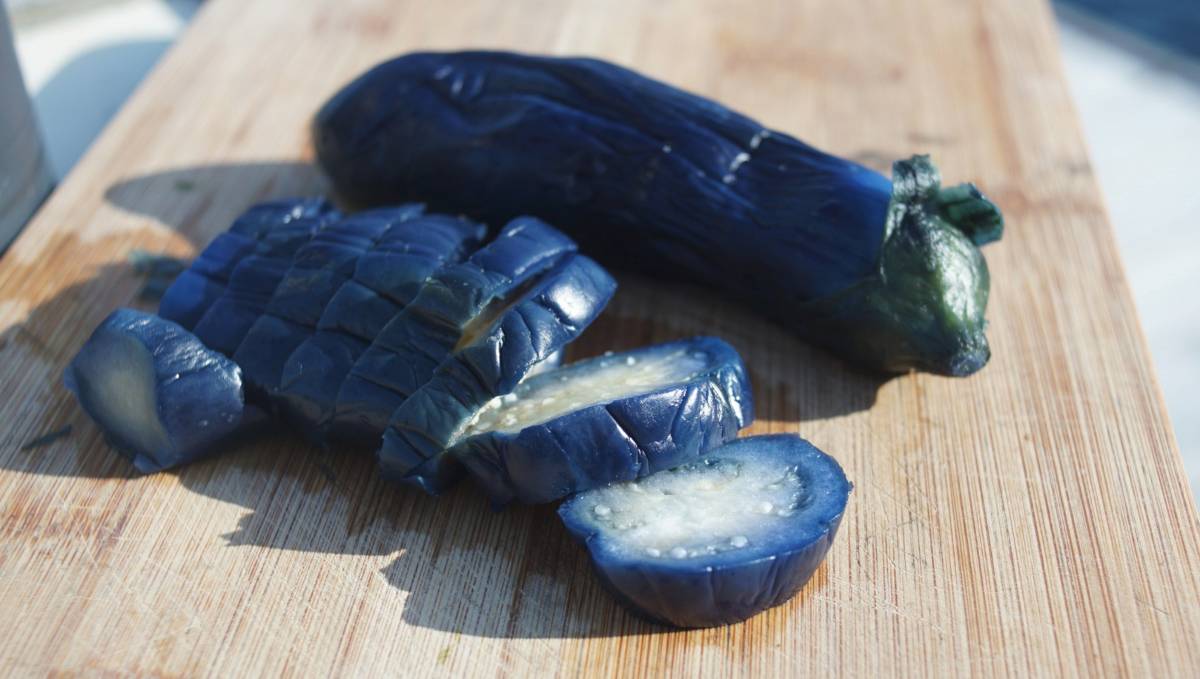
Food terms
- 食べ物 (tabemono) food
- 青果 (seika) vegetables and fruits
- 野菜 (yasai) vegetables
- 果物 (kudamono) fruits
- 飲み物 (nomimono) drink
- コーヒ(coohii) coffee
- ワイン (wain) wine
- ティ(cha) tea
- ビール (biiru) beer
- ミルク (miruku) milk
- 豆乳 (tonyuu) soy milk
- 水 (mizu) water
- 氷 (koori) ice
- おつまみ (otsumami) beer snack
- 漬物 (tsukemono) pickles
- 肉 (niku) meat 魚 (sakana) fish
- 揚げ物 (agemono) fried foods
- おにぎり (onigiri) rice ball
- 弁当 (bentou) lunch box
- ヨーグルト (yoguruto) yogurt
- アイスクリーム (aisu kurimu) ice cream
- カレ (kare) Japanese curry
- パン (pan) bread
- かしパン (kashipan) sweet bread
- お菓子 (okashi) sweets
- 油 (abura) oil
- 塩 (shio) salt
- ごま (goma) sesame seeds
- 黒コショウ (kuro koshou) black pepper
- 小麦粉 (komugiko) flour
- サラダ (sarada) salad
- うどん (udon) wheat noodles
- そうめん (soumen) thin noodles
- そば (soba) buckwheat noodles
- ラーメン (ramen) Chinese noodles
Flavors
- 酸っぱい (suppai) sour
- 甘い (amai) sweet
- 辛い (karai) spicy
- 苦い (nigai) bitter
- 旨味 (umami) savory
Meals
- 朝ごはん (asagohan) breakfast
- 昼ごはん (hirugohan) lunch
- 晩ごはん (bangohan) dinner
local produce
Vegetables
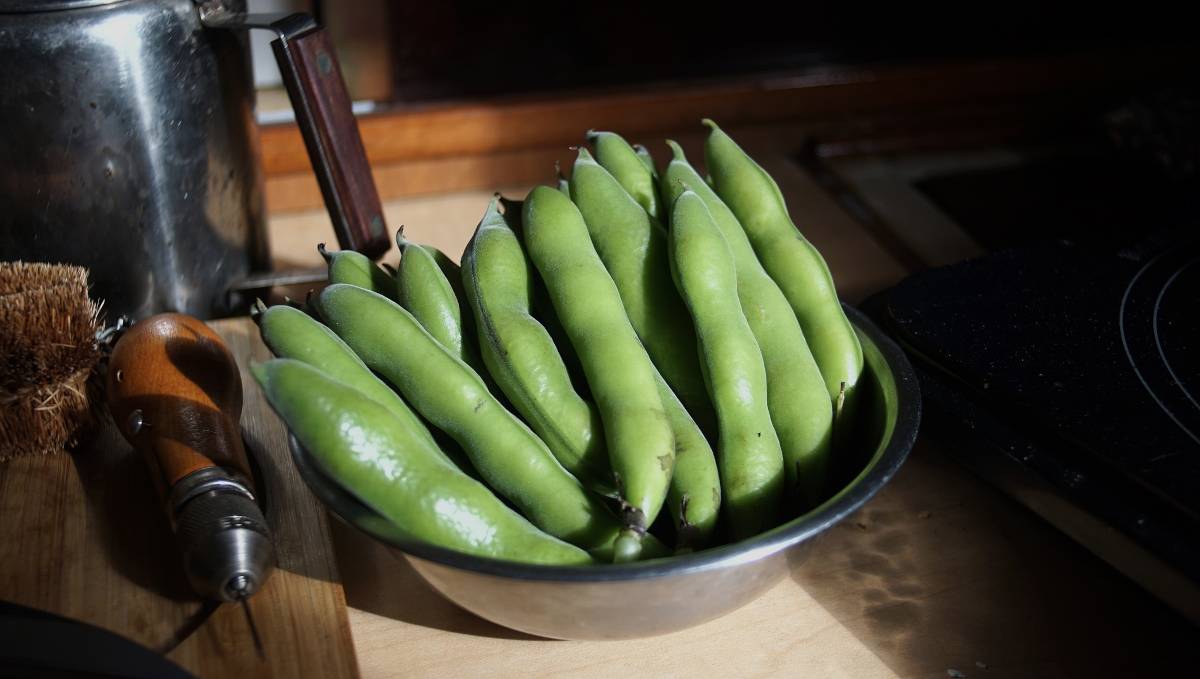
- ほうれん草 (horensou) spinach
- ミズナ (mizuna) mustard greens
- シソ (shiso) perilla leaf
- 小松菜 (komatsuna) mustard spinach
- さつまいも (satsumaimo) Sweet potato
- じゃがいも (jagaimo) potatoes
- 里芋 (satoimo) taro root
- 長芋 (nagaimo) Yam
- まめ (mame) beans (general)
- 蓮根 (renkon) lotus root
- ごぼう (gobou) burdock root
- にんじん (ninjin) carrot
- ニラ (nira) chives
- 玉ねぎ (tamanegi) onion
- 独活 (udo)
- 大根 (daikon) big white radish
- 林檎 (ringo) apple
- 生姜 (shouga) ginger root
- 竹の子 (takenoko) young bamboo
- ねぎ (negi) green onion, leek
- 山椒 (sanshou) Japanese peppercorns
- きゅうり (kyuuri) cucumber
- 枝豆 (edamame) young soybean
- オクラ (okura) okra
- とうもろこし (toumorokoshi) cob corn
- コーン (koon) corn
- 茗荷 (myoga) Japanese ginger
- 茄子 (nasu) eggplant
Fruit
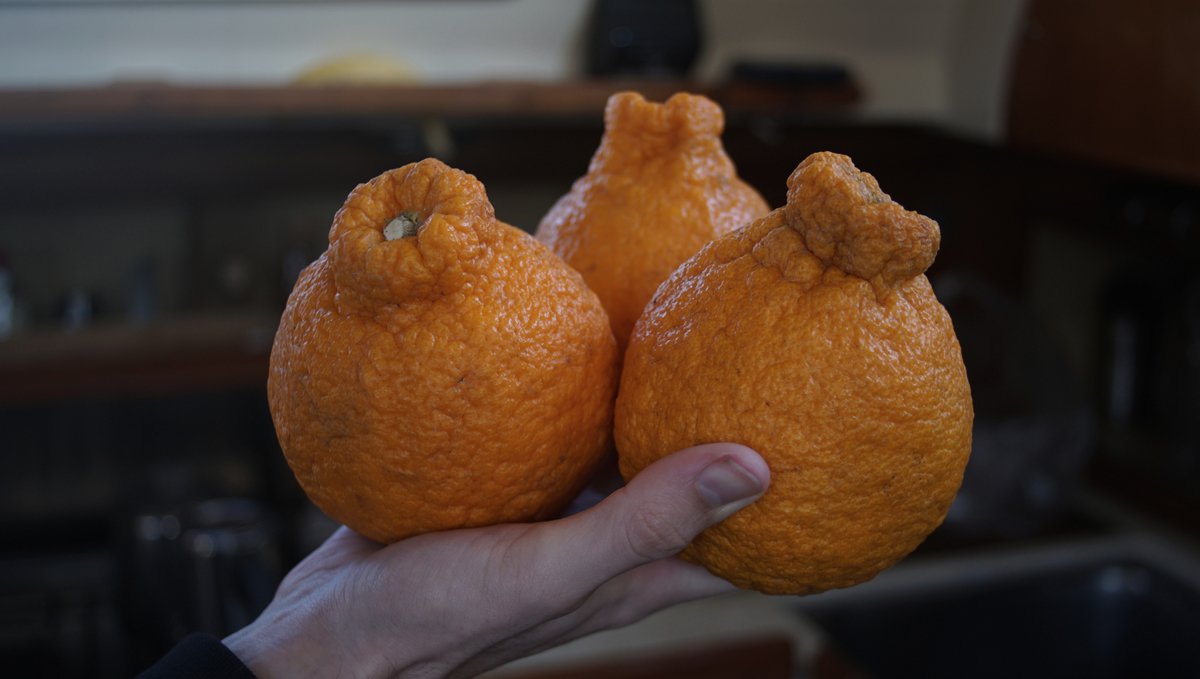
- 梨 (nashi) Japanese pear
- 林檎 (ringo) apple
- 柿 (kaki) persimmon
- みかん (mikan) mandarine orange
- ゆず (yuzu) lemon-like fruit
- メロン (meron) green melon
- 酢橘 (sudachi) sour lime-like fruit
- きんかん (kinkan) kumquat
- 桃 (momo) peach
- スイカ (suica) watermelon
- 桜んぼ (sakura n bo) cherry
- 梅 (ume) Japanese plum
- 葡萄 (budo) grape
- イチゴ (ichigo) strawberry
Phrases
Here are a few phrases that are useful when shopping for groceries.
Replace ~ with the food item you are looking for:
~がありますか
~ ga arimasu ka?
Do you have ~?
~はどこにありますか
~ wa doko desu ka?
Where is ~?
これはいくらですか
Kore wa ikura desu ka?
How much is this?
Replace ~ with the number of items you need.
If it's a small number, indicate the number
of items with your fingers:
これを~ください
Kore wo ~ kudasai
I'd like ~ of this
example: これをふたつください
Kore wo futatsu kudasai
I'd like two of this
はい、お願いします。
Hai, onegaishimasu
Yes please
ありがとうございます
Arigato gozaimasu
Thank you
supermarkets

Japanese supermarkets, or スーパ (suupa), are smaller than North American-style shops. In larger cities, shops don't always provide shopping carts because people buy food for this day and the next. Suupas sell meat, seafood, produce (veggie, fruits, mushrooms), dairy, soybean products (tofu, miso, soy sauce, natto), snacks (sweets, rice crackers), beer, liquor, pre-made deli dishes (salads, deep fried foods, lunch boxes) as well as rice, bread, noodles, cereals, sauces and frozen/canned goods.
When browsing for goods, you'll notice that the stores include the tax in the labeled price, and that they price fruit and vegetables per item, not per weight. Supermarkets are in the suburbs, towns and villages. They're harder to find in big city centers. Suupas open around 0900 or 1000, and close around 2100-2200.
Cashier checkout
When you walk to a register with your basket, leave the items in it and place it on the checkout counter. The cashier will process your items one-by-one, calling out the price of each item out loud. Then, they'll place the items in another basket (which you will take to a separate packing area). Some checkout counters have two people, one who scans your items and the other who handles the cash
Common names of supermarkets include: Seiyu, SUMMIT, LIFE, Maruetsu, Ito Yokado, Don Quixote, AEON, OK Store etc.
Neighborhood shops
Neighborhood shops are small stores that line a street called a 商店街(shoutengai), or shop street. You can find them everywhere. This is where residents do much of their daily shopping. Every shop specializes in the sale of one item, like fish, vegetables or produce. These types of stores typically open at 1000 and close after dark.
Among them are: 肉屋(niku-ya) meat shops, 魚屋(sakana-ya) fish shops, 鳥屋(toori -ya) chicken meat shops, 果物屋(kudamono-ya) fruit store, 八百屋(yao-ya) green grocer (vegetables), パン屋(pan-ya) bread shop, 酒屋(saka-ya) liquor shop, お茶屋(ocha-ya) tea shop etc.
Other specialty shops include those that make rice crackers (senbei), traditional sweets (wagashi) and pickled vegetables (tsukemono).
These shops are often lower priced than in supermarkets, especially when it comes to meat, fish and produce, but selection is limited.
konbini
Konbinis, or convenience stores, are open 24h/day, 6 days/week and 365 days/year. They don't close, even during holidays. They offer many services like WiFi, toilets, ATMs, machines to buy concert/bus tickets, and sometimes even tables to eat on-site. They stock prepared foods, beer, liquor, beer snacks (otsumami), heated cans of coffee, cold drinks, soft drinks, milk, desserts and a limited selection of fresh vegetables and fruit. Many konbinis sell basic medicine, toiletries and convenience items like socks, shirts etc.
Konbini stores: 7-Eleven, Family Mart, Lawson, 100 Lawson (dollar lawson), Natural Lawson (organic food), Mini Mart, AM PM etc.
depachika
Below the surface, in the basements of department stores are food floors known as 'depachika' (デパ地下 literally: department store underground). Depachikas are a great place to pick up bento, snacks, souvenirs, groceries, gifts, souvenirs and desserts.
Food in depachika is expensive, but their selection is incredible. They carry many high-end products, so it might be worth going if you're looking for a rare item. Japanese people will visit to buy ceremonial and seasonal gift items.
discounted items
Many supermarkets mark down unsold lunch items around 1400, and other prepared foods around 1900. Discounts start off at 10-20 %, and increase until closing. Supermarkets also discount fruit and veg in this way.
fruits and vegetables
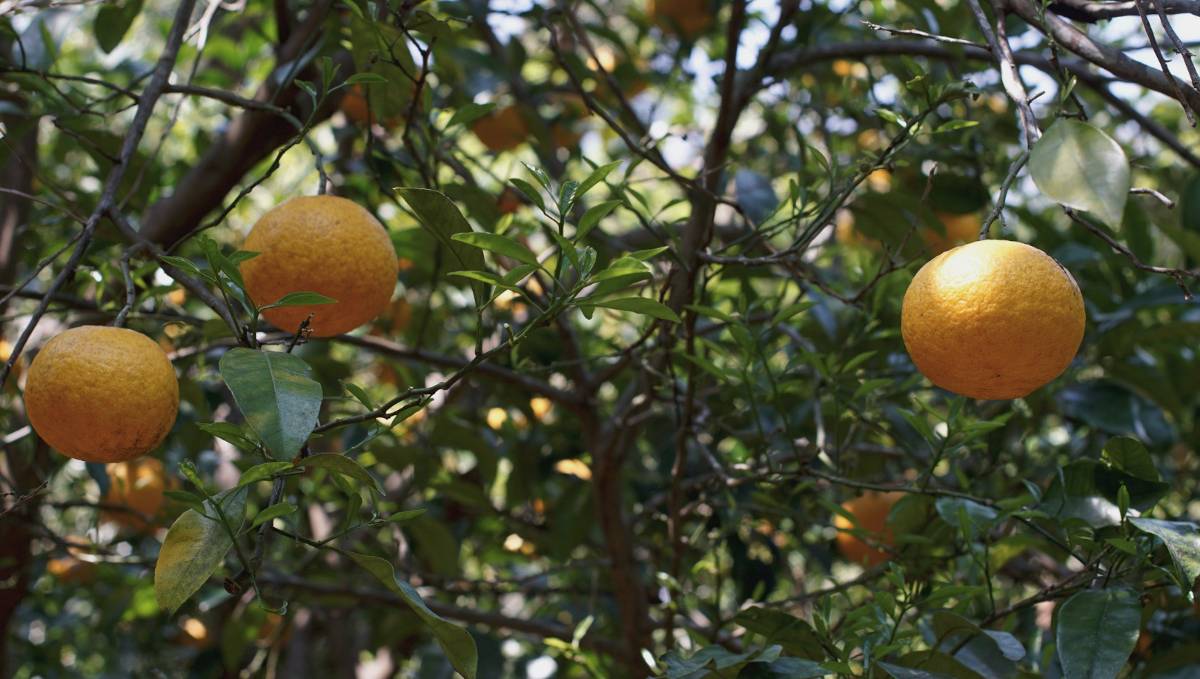
Japanese groceries are well-stocked, but fruit and veg (especially fruit) are pricey. This is because the Ministry of agriculture regulates production, and ensures output of the highest quality. As a result, the Japanese buy select fruit as a special treat, or as a gift.
The use of seasonal ingredients in food has high value in Japan. Here, we introduce local produce by season:
Summer
Corn, edamame, goya, okra, eggplant, shiso, tomato, lettuce, bell pepper, summer cabbage, kyuuri (cucumbers), chinese plums, muskmelon, peach, watermelon, yuzu, grape and cherries
Fall
Sweet potato, matsutake, saitomo, pumpkin, ginkgo nuts, rice (first harvest), shimeji, shiitake, maitake, sudachi, Japanese chestnuts, kaki and Japanese pears
Winter
Chinese cabbage, daikon, renkon, turnip, cabbage, minkan (mandarin/satsuma oranges), strawberry and apples.
Spring
Bamboo shoots, udo, shiitake, potatoes, strawberry, citrus and loquat.
fresh markets
Many cities in Japan have farmer's markets. In Japanese, they're called 朝市 (asaichi), which translates to "morning markets". They're not easy to find if you don't speak the language, plus their schedules vary month to month per location. To find a market in your area, try to search online for 朝市 or ファーマーズマーケット, plus your city/area name in Japanese.
For example, if you live in Mie (三重), you would type 朝市 三重. You can also try and search through Asaichi network service, or asking locals by saying:
朝市は近くにありますか Asaichi wa chikaku ni arimasu ka? Is there a farmer's market nearby?
Markets
- Farmer’s Market at UNU (Aoyama, Tokyo) weekends
- Market of the sun (Tsukishima, Tokyo) 2nd weekends
- Yurakucho Market (Tokyo) weekends
- Koenji Market (Koenji, Tokyo) 3rd saturdays
- Nara Organic Farmers Market (Nara)
- Ashikita Sashiki Farmers Market (Kushimoto)
- Okayama's farmer's market (Okayama)
- Itadaki Ichi (Owase, Mie)
counting
When counting in Japanese, there are some phonetic modifications to larger numbers involving voicing or gemination of certain consonants.
Examples:
ichi (1) + hyaku (100) is pronounced as ippyaku (100) san (3) + hyaku (100) is pronounced as sanbyaku (300) roku (6) + hyaku (100) is pronounced as roppyaku (600) hachi (8) + hyaku (100) is pronounced as happyaku (800) ichi (1) + sen (1,000) is pronounced as issen (1,000) san (3) + sen (1,000) is pronounced as sanzen (3,000) hachi (8) + sen (1,000) is pronounced as hassen (8,000)
When purchasing goods in a store, if you ask, "いくら? (ikura) how much?", in response you'll likely hear something like:
三千円です
Sanzen en desu
It's JPY3000
Read more about Japanese numerals here.
Numbers
- 一 (ichi) one
- 二 (ni) two)
- 三 (san) three
- 四 (shi) four
- 五 (go) five
- 六 (roku) six
- 七 (nana) seven
- 八 (hachi) eight
- 九 (kyuu) nine
- 十 (juu) ten
- 十三 (juu-san) thirteen
- 二十 (ni-juu) twenty
- 三十 (san-juu) thirty
- 四十 (shi-juu) forty
- 五十 (go-juu) fifty
- 六十 (roku-juu) sixty
- 七十 (shichi-juu) seventy
- 八十 (hachi-juu) eighty
- 九十 (kuu-juu) ninety
- 百 (hyaku) hundred
- 千 (sen) thousand
- 万 (man) ten thousand
The Japanese language has many different kinds of counters, to count different types of objects like tall cylindrical objects (本 hon) or flat ones (枚 mai). I won't go through all of these here, but knowing numbers 1-10 is useful.
vocabulary
- 一つ (hitotsu) one
- 二つ (futatsu) two
- 三つ (mittsu) three
- 四つ (yottsu) four
- 五つ (itsutsu) five
- 六つ (muttsu) six
- 七つ (nanatsu) seven
- 八つ (yattsu) eight
- 九つ (kokonotsu) nine
- 十 (too) ten
Phrases
幾つ (ikutsu) how many? それ を 二つ ください (Sore o futatsu kudasai) Please give me 2 of those. Literally: Those two please.
Saying no to plastic bags
Japan takes pride in the quality of its customer service, they treat clients with the utmost respect by paying attention to details and offering convenient items like plastic bags, forks, spoons, and chopsticks. These items are all included by default, at no extra charge.
If you prefer to avoid non-reusable products, how do you communicate this politely in Japanese?
Useful words
- 大丈夫 (daijoubou) ok
- おもち (o mochi) to have
- いります (irimasu) Verb, to 'need'
- ください (kudasai) please
- けっこうです (kekkou desu) No thanks.
- その まま で (sono mama de) as is
- ストロー (sutoraa) Straw
- おはし (ohashi) Chopsticks
- スプーン (Supuunu) Spoon
- フォーク (fookuu) Fork
- 紙袋 (kamibukuro) Paper bag
- 袋 (fukuro) bag
How to decline bags in Japanese.
袋、けっこうです (bukuro kekkou desu) No shopping bag、 thank you. 袋 は いりません (fukuro wa irimassen) I don't need a bag その まま で ください (sono mama de kudasai) I'll take it as is. 袋 は 大丈夫 です (fukuro wa daijoubou desu) I'm okay for a bag.
The cashier will respond with kashikomarimashita(かしこまりました) which is a polite expression meaning "understood". Sometimes, the cashier will ask if you want a bag by saying:
袋 を おもち です か? Furuko o mochi desu ka? Do you have a bag? Your answer: はい、大丈夫 です Hai, daijoubou desu Yes, it's okay. I don't need a bag. Literally: Yes, it's okay. In other cases, the cashier might ask... 袋 お いりますか? Fukuro o irimasu ka? Do you need a bag? Your answer: いいえ、大丈夫 です Iie, daijoubou desu. No, I'm ok without a bag.
If you buy a prepared dish, they will ask you if you want chopsticks, and you can decline using the examples above by replace 'fukuro' with 'o hashi'(お はし).
Provisioning online
It is possible to order some goods online. If at a marina for a while, this method of provisioning should be considered. If you don't mind using Amazon, Amazon.co.jp offers a lot of variety (it's the only way we could buy large quantities of cans). It's possible to order Costco food through Foreign's Buyer's club, but it's very pricey and takes a while to ship (we did not try this option).
Here is a list of websites and stores where you can buy difficult-to-find items:
- Cuoca
- Foreign buyer's club
- Alishan (online)
- Kaldi (online, there's also a store)
Cans
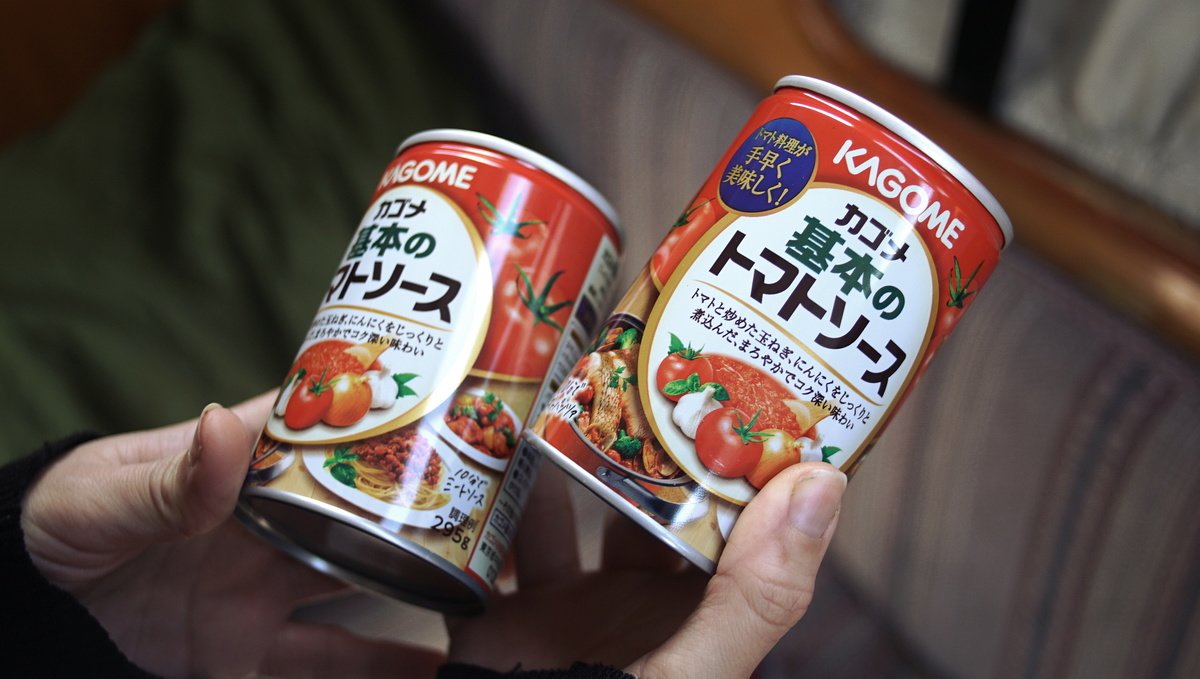
Japan has almost anything available in canned form, whether it be canned balsamic sauce, canned bread, or canned smoked mackerel. Neighborhood supermarkets have a smaller range available, especially when it comes to vegetables, but they have plenty of canned seafood/meats. Many of the canned seafood is flavored with sauces, making it easy to add onto meals during passages — something to consider.
Amazon Japan stocks packs of 24x300 g cans of soybeans, which are delicious when used instead of chickpeas in hummus, look for いなば大豆水煮 (inaba — company name — boiled soybeans in water) if you're interested in purchasing these. We hate recommending Amazon, but if in a remote place in Japan it is often the only way to buy food in large quantities. Most supermarkets don't stock items in bulk.
condiments
Japan has many condiments, I'll go through the most popular ones, listing their properties and uses.
Mirin
Mirin, or 味醂 or みりん, is a condiment in Japanese cuisine. It's a type of rice wine but with a lower alcohol and higher sugar content than sake. The sugars form naturally during the fermentation process, and are not added.
There are 3 types: Hon mirin (true mirin), which contains about 14% alcohol, second is Shio mirin which has less alcohol (lower than 1.5%) and third is Shin mirin, which has less than 1% alcohol while retaining the same flavor.
Mirin adds sweetness to dishes, it helps tenderize foods while masking unwanted flavors and adds luster to dishes.
Soy sauce
Soy sauce, called Shoyu(醤油), is a staple of Japanese cuisine and is as ubiquitous as salt. The Japanese use is to flavor and enhance dishes, to season ingredients, to enhance the color of dishes and to make sauces and dressings.
Japanese soy sauce is more delicate than Chinese, Korean or Thai soy sauce. It has a complex umami flavor. There are 3 types:
- Koikuchi shoyu (濃口醤油, dark-colored soy sauce)
- Usukuchi shoyu (薄口醤油, light-colored soy sauce)
- Amakuchi shoyu (甘口, sweet soy sauce)
Koikuchi is available in Eastern Japan, it is dark-colored with a slight fruity flavor. It's made with a higher ratio of soybeans, and is sometimes produced without wheat. Usukuchi is light, and has a saltier taste, it is preferred in the West of Japan. Light soy sauce is ideal to make noodle soup or simmered dishes. Amakuchi soy sauce is sweet and common in Southern Japan.
Miso
Miso, or みそ, is a traditional Japanese seasoning produced by fermenting soybeans with both salt and koji (fungus Aspergillus oryzae) and sometimes with rice, barley and seaweed. Miso is salty, but its flavor and aroma depends on the ingredients used or the fermentation process.
There is a wide variety of Japanese miso, it is typically classified by grain type (barley, buckwheat, rice etc), color (white, brown, black & red), taste (sweet 甘味噌, mild 甘口味噌, salty 辛口味噌, earthy, fruity etc) and background (where it's from). The most common miso flavor categories are:
- Shiromiso 白味噌 (white)
- Akamiso 赤味噌 (red)
- Awasemiso 合わせ味噌 (mixed)
Miso is delicious when used in soup, as a dressing for salad, in ramen, as a flavoring for tofu etc
Rice vinegar
Japanese Rice vinegar 米酢 'komezu' or simply 'su' has a very mild taste, and is either colorless or yellow. Japanese rice vinegar is made from rice. This type of vinegar is less acidic than Chinese varieties, and are used to season rice, and for making 'sunomono' (vinegar dishes) and 'tsukemono' (pickles). There are some kinds of Japanese rice vinegars that are 'seasoned', meaning that they have additives like sake, salt and sugar, for added flavor. Seasoned varieties include 'sushizu'.
Rice vinegar is known for its antibacterial properties.
Dashi
Dashi is a soup stock and essential condiment in Japanese cuisine. Dashi contains one or two ingredients, and is often made from konbu 昆布だし (dried kelp), katsuobushi (dried bonito flakes), shiitake (mushrooms), iriko/niboshi (dried anchovies/sardines) or a combination of these. Dashi creates a sweet, savory umami flavor.
Dashi is used as a broth base for Japanese hot pot dishes, simmered dishes, noodle soups, it's also used as a seasoning liquid (for rice). Kombu dashi is the easiest stock to make, it has a subtle taste and is often mixed with shiitake dashi. The mushrooms used to make shiitake dashi are used for cooking.
Peanut butter
Peanut butter is sometimes available, but is more common in big cities like Tokyo. There are 3 main varieties:
- ピーナッツペースト, peanut butter pesto
- ピーナッツバタークリーム (or クリーミー) peanut butter cream
- ピーナッツバターpeanut butter
Peanut butter 'pesto' is 100% ground peanuts without additives. Peanut butter cream is very very sweet (tastes more like caramel) and peanut butter can be both 100% peanuts and one with additives such as salt, sugar and oil.
Common brands of peanut butter include: Saniku Foods Peanut Butter, Youki foods, Smuckers, Meidi-ya, Whole earth, Skippy and Alishan Organic Peanut butter.
Sweetened varieties of peanut butter, like Skippy, are almost always available at large supermarkets that deal with imported goods, such as Seijo Ishii, Yamaya, Reimei or Meiji-ya. Pesto peanut butter is harder to find in store, but it is available. Brands like Saniku foods are sometimes sold in regular grocery stores, Pic's is reserved for special stores, while Alishan products are sold online. I'd avoid peanut butter cream as much as possible, it's very, very sweet and doesn't taste at all like peanuts. Peanut butter cream is often sold in kombini in small jars with a drawing of a peanut on top, try it if you're curious but if you hate overly sweet foods you will not enjoy the experience.
rice
Rice is a staple crop in Japan, it's a daily source of energy and plays an important part in many aspects of Japanese culture. It's importance cannot be overstated.
The rice is planted in the spring, and harvested in early September. There are many kinds of rice grown in Japan, but the most common is the short-grain type. The main types are uruchimai 粳米(sushi rice) and mochigome 餅米 (for sweets, rice cakes).
Below is a list of kanji that you can use when navigating the shelves:
米 (kome) raw rice 白米 (hakumai) white rice 玄米 (genmai) brown rice 精米 (Seimai) milled rice 無洗米 (Musenmai) unwashed rice 特別栽培米 (Tokubetsusaibaimai) specially cultivated rice 発芽玄米 (hatsuga genmai) germinated brown rice 米ぬか (komenuka) rice bran
Most supermarkets in Japan sell ready-polished rice in 10 kg, 5 kg, and smaller bags. Brown rice is sometimes sold in 30 kg bags. Price of rice can vary from 300 – 2,000 JPY per kilo. Price is driven by quality, scarcity, and processing.
There are many words for rice in Japanese::
米 kome (raw uncooked grain )
ご飯 gohan (cooked rice)
飯 meshi (also cooked rice)
As a final note on rice, if you want to make your meals more interesting you can buy ふりかけ (furikake), which is a dry Japanese seasoning that you can sprinkle on top of cooked rice and other dishes. There are many flavors consisting of a mixture of chopped seaweed, sugar, salt, shiso, vegetables, katsuoboshi, dried fish etc.
Furikake was commercialized in 1948 on the basis that it provided a good source of protein and calcium to Japanese people, it was manufactured to address pervasive malnourishment during World War I.
Pasta
Supermarkets sell western-style dried pasta, with many imported from both Italy and the US. There are some brands produced locally, all made from white flour. Spelt or wholewheat pasta is very rare, but Japan does carry other kind of whole grain flours:
Japan has some local varieties:
Soba そば : Brown noodles made with buckwheat flour, often served at room temperature and served with a dipping sauce. Soba is also served hot, with broth. Usually sold dry in supermarkets. Buckwheat is a pseudocereal, but makes an excellent pasta alternative.
Udon 饂飩 : Thick wheat noodles, served in hot soups. Available as fresh noodles in supermarkets.
Kishimen きし麺 : Noodles in flat strips, similar to udon. They're served in dished cooked at the table, casseroles or winter soups. Kishimen don't become soggy when cooked for a long time.
Hiyamugi 冷や麦 : Noodles that are similar to spaghetti, but that are served chilled with a dipping sauce (in summer).
Soumen 素麺 : Fine white noodles, similar to vermicelli. Usually sold in short strands. They come in different colors, sometimes green, pink or yellow. Eaten in summer.
Chuuka soba 中華そば : Chinese noodles made from wheat, usually sold in a yellow color. They're sold in supermarkets (fresh or dried). These noodles are stir-fried with veggies and sauces to make 焼きそば yakisoba.
Tofu
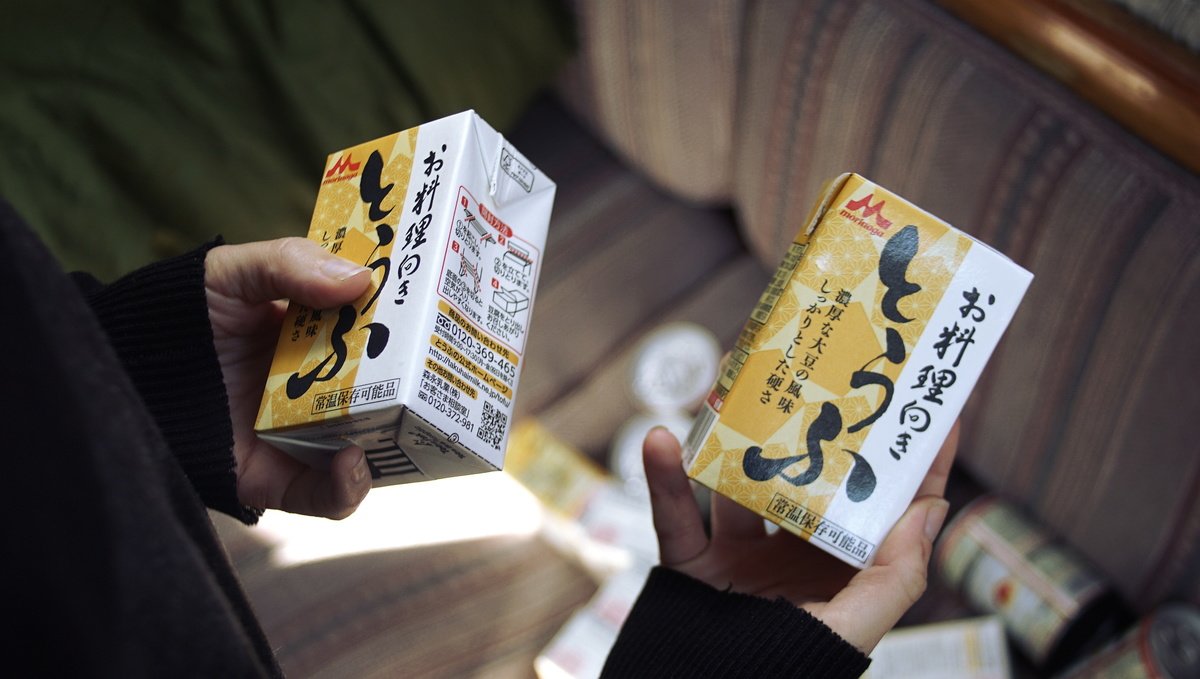
Tofu is a high-protein, low-fat and nutritious food. Its subtle flavor makes it ideal when served in soups, sautees, or as a dessert. Japanese supermarkets sell many varieties of tofu:
絹豆腐 (kinu-doufu) : Kinu-toufu is soft, or silken tofu. It's very delicate. It's also called 絹ごし (kinu-goshi) or just きぬ kinu.
木綿 (momen) : Momen tofu, or 'cotton' tofu, is more coarse and dense.
焼きどうふ (yaki-doufu) : Momen tofu with a seared surface, easy to recognize through the packaging because of the sear marks on its surface. Often used in sukiyaki.
生揚げ (namaage) : Deep-fried bean curd. The outer surface is a light golden color, while the inside is still soft. When preparing it, pour hot water over them to help remove the oil in which they were fried.
油揚げ (abura-age) : Thin deep-fried slices of tofu. It's sold in supermarkets in pouch form, used to make いなり寿司 (inari-zushi). When preparing it, pour hot water over them to help remove the oil in which they were fried.
雪花菜 (okara) : Okara is soy pulp, a byproduct of making tofu. It's sold fresh, but also in powdered form.
高野豆腐 (kouya-doufu) : Kouya-doufu is freeze-dried tofu. The variety sold in stores is made with soy, coagulants, and baking soda. It resembles a hard sponge, and needs to be re-hydrated for 5 minutes, and then firmly pressed before use. It can be ground into tofu meal and flour. Japan has a long history of freezing foods that contain a large amount of water, then thawing and drying them to remove all moisture to produce a lightweight, dehydrated food with a long shelf life. This practice is said to have originated on Mt. Koya.>
常温豆腐 (jouon toufu) : This type of tofu is shelf-stable. It is sold in a tetra pak and ideal for sailors. It's hard to find in stores, we found some while in Ogasawara, but not since. They're easy to find online, and are sold in 297 g packs of 12-24. They are produced by 森永 Morinaga, and use the following ingredients: Whole soybean (from US, Canada) (non-gmo), soy protein and a coagulant. Here are the two types we found:
- お料理向きとうふ (o ryouri-muki toufu) tofu for cooking, firm (yellow packaging).
- 絹ごしとうふ (kinugoshi toufu) silken tofu (blue packaging).
Most soft tofu sold in groceries is packed with liquid in a plastic tub, while fried versions don't have liquid. Tofu spoils quickly and needs to be refrigerated. Tofu typically has added ingredients, a combination of stabilizers and coagulants. It is high in iron, and can have a high calcium or magnesium content depending on the coagulants (e.g. calcium chloride, calcium sulfate, magnesium sulfate) used in manufacturing.
milk
For a long time, the consumption of cow's milk wasn't prevalent in Japan, it was a product reserved for the elite. It wasn't until the Westernization of the country during the Meiji Era of late 19th century that it trickled down to the common people.
It was the Japanese government itself that introduced dairy into the Japanese diet, alongside meat, despite being banned for centuries by Buddhist edict. The Meiji leaders felt that it was important to develop a military on par with America or Europe, and that the only way to do that was to adopt Western habits. 19th century Western science of nutrition regarded beef and dairy as an ideal food essential to human growth. Refraining from consumption was generally perceived in the West as a disadvantage in terms of physical, intellectual and even moral strength. It became a matter of perception, not adapting to foreign ideals was regarded as a sign of backwardness. Read more about it here(.txt file), I also recommend checking out The Politics of Food by Marianne E. and Brigitte N.
Milk products vocabulary
- ミルク (miruku)
- 牛乳 (gyuunyuu)
- 粉乳 (funnyuu) powdered milk
- チーズ (chiizu) cheese
- マヨ (mayo) mayonnaise
Soy milk
Japan produces its own milk and soy milk, both products are sold in the same section (usually). Otherwise, soy milk is found near other soy foods. Japan sells over 50 varieties of soy milk, which includes flavors like banana, green tea, mango etc. Japanese soy milk usually comes in 1-liter containers, while other flavors will mostly be available in smaller 250 ml containers.
- 豆乳 (tonyuu) soy milk
- 無調整豆乳 (mu chousei tonyuu) non-adjusted soy milk (vegan) 調整豆乳 (chosei tonyuu) adjusted soy milk (may not be vegan)
Common brands: Kikkoman, Marusan, Otsuka etc.
Oats
Oats is labelled as オートミール (oatmeal) on store packaging. Oats are rare in Japan, like morning cereal, it's not something locals eat and so there is little reason to keep some in stock. This doesn't mean it doesn't exist, they have it, but the bags are small and expensive. Groceries that stock imported products usually carry Quaker Oats oatmeal.
It's more cost-effective to buy oats online on Amazon or Cuoca. Common brands of oats include Tomiz, Alishan and Misshoku's.
Japanese alternatives
Here is a list of alternatives to oats:
お茶漬け (ochazuke) : A simple soft rice dish which combines green tea, steamed rice, and an assortment of savory ingredients. It has a similar texture to oatmeal and is available in quick-cooking portions.
麦 mugi (barley) : Barley is popular in Japan, it's often added to plain rice for added nutrition and bulk. There's a special variety of barley available called もち麦 (mochi mugi), it contains more fiber than brown rice and regular barley (Hakubaku is the leading brand for mochi mugi). In the late 18th century, the grain was introduced in diets of Japanese soldiers to combat beriberi, a medical condition of low levels of thiamine (vitamin b1) and result of consuming too much polished rice. Another great aspect of barley is that the unhulled kernels are delicious when roasted and used as tea, known in Japanese as 麦茶 (mugi cha).
Baking goods
Japanese grocery stores always carry white flour, but whole grain flour is rare. Here are the main varieties:
薄力粉 (hakurikiko) weak flour/soft flour (baking and general use) 強力粉 (kyoryokuko) strong flour (bread making) 全粒粉 (zenryufun) whole wheat flour スペルト小麦粉 (superuto komugiko) spelt flour ライ麦粉 (raimugiko) rye flour
White flour is easy to find in most grocery stores, but whole grain varieties are more rare (they can be purchased online in bulk through Cuoca or Amazon). Self-raising flours are not sold in Japan.
Common brands of whole grain flours include Pioneer (2 kg), Nisshin (1 kg), Tomiz (1 kg) and Ebetsu (5 kg).
Baking terms
- ベーキングパウダ (beikingu paudaa) baking powder
- ドライイースト (dorai yeesuto) dry yeast
- 予備発酵不要 (yobi hakkou fuyou) quick yeast
- 重曹 (Juusou) baking soda
- 小麦 (komugi) wheat
- 小麦粉 (komugiko) flour
- フラワー (furawa) flour
- 漂白 (hyohaku) bleached
- 無漂白 (muhyouhaku) unbleached
- ショートニング (shootoningu) shortening
- バター (bataa) butter
- 砂糖 (satou) sugar
- ブラウンシュガー (buraunshugaa) brown sugar
bread
There hasn't been a long tradition of baking in Japan, nor of consuming baked products, but modern groceries carry a variety of fresh breads like croissants, dinner rolls and french-style breads. The breads are often white with a cake-like consistency. There are exceptions, as some supermarkets carry small whole wheat loaves (also, cake like though). Some large supermarkets bake bread on the premises, with some loaves sold either whole or slices. Finding artisan-style bread is not easy, but it is possible. Bigger cities have German or French-style bakeries (usually located in large shopping malls), which offer a variety of both sweet and savory breads.
frozen foods
Japanese people prefer to buy fresh foods over frozen products, but supermarkets do stock a variety. A lot of prepared frozen goods are Chinese-style dishes, like dumplings and fried goods, and sometimes Western-style hamburgers.
Vegetables
Peas, corn, edamame (green soybeans), mushrooms, string beans, asparagus, potatoes, garlic etc.
Seafood
shrimp, clams, scallops, eel etc.
Juice
Juice is sold fresh, bottled, canned and in frozen concentrate (like in the US), and comes in a variety of concentrations. The percentage of fruit juice 果汁 (kajuu) is indicated on the label with a percent sign. Added sugars are listed as 砂糖 (satou).
ジュース (juusu) juice 果汁 (kajuu) fruit juice 未満 (miman) less than
Beans and legumes
Finding certain varieties of beans or legumes (chickpeas, kidney beans, lentils) is difficult in grocery stores. Beans are often sold in small plastic pouches (1 portion), or in tiny cans (also 1 portion). Chickpeas are available in larger cans at stores like Kaldi, but it's not cheap.
Dried chickpeas are even rarer birds, I'd suggest making the switch to local products:
Alternatives
小豆 (azuki) red bean : The aduki bean is a tiny, reddish-brown bean with a cream coloured seam and sweet, nutty flavour. in Japan, azuki is an ingredient in 赤飯 (sekihan), a traditional dish consisting of sticky rice steamed with adzuki beans, which give a reddish color to the rice. Other uses for azuki include あんこ (anko) sweet read bean paste and ぜんざい (zenzai) red bean soup.
黒豆 (kuromame) black bean : A type of soybean that isn't related to Western black beans. They are two to three times the size of normal soybeans, round when dried, and have a deep ebony hue. Kuromame is usually eaten with rice, and is serve during New Year celebrations. See a recipe.
大豆 (daizu) soybeans : Soybeans are a versatile food and one of the central ingredients of Japanese cuisine. They're processed into many products like 醤油 (shoyu) soy sauce, 納豆 (natto) fermented soybeans, 豆乳 (tonyu) soymilk, 黄粉 (kinako) roasted soybean flour, おから okara, yuba, みそ miso and 豆腐 tofu. Soybeans are a very good chickpea alternative to make hummus.
Household products
Some of the large supermarket chains package their own brands of household products at prices slightly lower than those of name brands. Also, no-brand (mujirushi) products are available at even greater savings.
Vocabulary
- アルミホイル (aruminyuumu hoiru) aluminum foil
- 漂白剤 (hyoohakuzai) bleach
- トイレットペーパー (toiretto peepaa) toilet paper
- 洗濯洗剤 (sentaku zenzai) laundry detergent
allergies
The word for allergy is アレルギー or 'arerugii'. The Japanese Agricultural Standards (JAS) Law stipulates 27 types of allergens that must be labeled on processed foods. These include milk (乳), eggs (卵), flour (小麦), buckwheat (そば), peanuts (落花生), shrimp (えび), crab (かに), abalone (あわび), squid (いか), salmon eggs (いくら), orange (オレンジ), kiwi (キウイフルーツ), beef (牛肉), walnut (くるみ), alcohol (酒), mackerel (さば), soy (大豆), chicken (鶏肉), pork (豚肉), matsutake mushroom (まつたけ), peach (もも), yam (やまいも), apple (りんご), gelatin (ゼラチン), banana (バナナ), flax/sesame (ごま), cashew (カシューナッツ).
It should be noted that these 20 allergens are recommended for labeling, not mandatory, so products containing these allergens may not be overtly labeled.
Reading food labels
Nutrition labels
The top row in the nutritional information box says 栄養成分表示, 栄養成分 (eiyoo seibun hyooji, eiyoo seibun) all translated to nutrition facts. To the right of that you can see a number and amount ex: 100gあたり (or 当たり), which translates to per 100 g which is the serving size. On the second row, エネルギー or 熱量 (enerugii, netsuryoo) means energy or calorie, next will likely be たん白質 (tan hakushitsu) protein, 脂質 (shishitsu) fat, 炭水化物 (tansuikabutsu) carbohydrates and ナトリウム (natoriumu) sodium. Some labels will list 糖類 (toorui) sugar and 食塩相当量 (shokuen sootoo-ryou) salt equivalent.
On other products you might see a column on the right hand side of the main list 関与成分 かんよせいぶん (kanyo seibun) which means included ingredients.
On more complicated labels, they will include specific vitamins, divided under 糖類 sugars and/or 食物繊維 dietary fiber.
Ingredients list
品名 (hinmei) product name 原材料名 (genzairyoo-mei) raw ingredients name 内容量 (naiyouryou) quantity 賞味期限 (shoomi kigen) best eaten by date 保存方法 (Hozon hoohoo) how to store the product 販売者 (hanbai-sha) the company/distributor info
Fruit and veggie labels
無添加, むてんか, (mutenka) no additives 有機, ゆうき (yuuki) organic
Price labels
When buying fresh meat, fish, produce or prepared foods, you'll find a price label with a lot of information written on it. Here's how to decipher it all:
加工年月日 (kakou nengappi) date of packaging 100グラム当たり円 (hyaku guramu atari en) price per 100 g (in yen) 正味量 (shoumiryou), net weight 価格,値段 (nedan, kakaku) price
The date is expressed in the order 年 year, 月 month and 日 day. The year is usually given in terms of the era-name and year of reign of the current emperor.
Food additives vocabulary
This list of items is to help identify more obscure kanji when translating labels. This is purely in the interest of knowing what's in the food.
- 香料 (kouryoo) flavoring
- 安定剤 (anteizai) stabilizing agent
- 乳化剤 (nyuukazai) emulsifier
- 乳酸カルシウム (nyuusan karushiumu) calcium lactate
- 乳酸Ca (nyuusan karushiumu) calcium lactate
- ゲル化剤 (gerukazai) gelling agent (animal & plant)
- 酸味レギュレータ (sanmiregyureeta) acidity regulator
- 抗粘結剤 (konenketsuzai) anti caking agent
- 炭酸カルシウム (tansankarushiumu) calcium carbonate
- リン酸カルシウム (rinsan karushiumu) calcium phosphate
- カラメル色素 (karameru shikiso) caramel color
- 凝固剤 (gyokozai) cellulose
- 着色料 (chakushokuryoo) coloring
- 調整剤 (chooseizai) conditioning agent
- デキストリン (dekisutorin) dextrine
- 調味料 (cho-miryo-) flavor enhancer
- 食品酸 (shokuhinsan) food acid
- ぶどう糖 (budo-to-) glucose
- 粘剤 (nebazai) gum
- 膨張剤 (bo-cho-zai) leavening agent
- レシチン (reshichin) lecithin
- 塩化マグネシウム, えんかマグネシウム (enkamaguneshiumu) magnesium chloride
- 麦芽糖 (bakugato-) maltose
- 加工でんぷん / 加工でん粉 (kako-denpun) modified starch
- オリゴ糖 (origotoo) oligosaccharide
- ph調整剤 (ph cho-seizai) ph adjusting agent
- リン酸 (rinsan) phosphoric acid
- 増粘多糖類 (zoonentato-rui) polysaccharide thickener
- 酸カリウム (san kariumu) potassium
- 塩化カリウム (enkakariumu) potassium chloride
- クエン酸カリウム (kuen san kariumu) potassium citrate
- 防腐剤 保存料 (hozon-ryoo, boofu-zai) preservative
- プロピオン酸 OR プロピオンさん (puropionsan) propionic acid
- たんぱく加水分解物 (tanpakukasuibunkaibutsu) protein hydrolyzate
- ソルビトール (sorubitōru) sorbitol
- 安定剤 (antei-zai) stabilizing agent
- 澱粉, でんぷん, スターチ (denpun, sutaachi) starch
- 水飴, 水あめ, みずあめ (mizuame) starch syrup
- ステビア (sutebia) stevia
- 蔗糖, スクロース (shotoo, sukurosu) sucrose
- 甘味料 (kanmi-ryoo) sweetener
- 増粘剤 (zoonenzai) thickener
- 豆腐用凝固剤 (tofuyogyokozai) tofu coagulant
- ビタミンC (bitaminshī) vitamin C
- ビタミンD (bitamindī) vitamin D
references
- World Markets for Organic Fruit and Vegetables
- Japan crops
- History of soyfoods
- Food agriculture in Japan
- Soy foods
- Dairy products in Japan
- A little shop in Tokyo
- Just one cookbook
- A guide to food buying in Japan by Carolyn R. Krouse